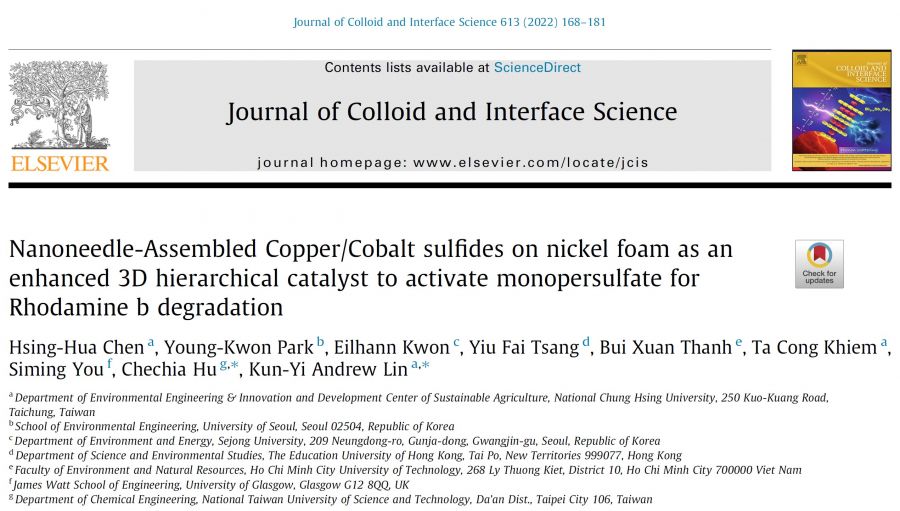循環農業:農業廢棄物高價值化【環境工程學系/林坤儀特聘教授】
| 論文篇名 | 英文:Nanoneedle-Assembled Copper/Cobalt sulfides on nickel foam as an enhanced 3D hierarchical catalyst to activate monopersulfate for Rhodamine b degradation 中文: 泡沫鎳上納米針組裝的銅/鈷硫化物作為增強的 3D 分級催化劑激活單過硫酸鹽以降解羅丹明 b |
| 期刊名稱 | JOURNAL OF COLLOID AND INTERFACE SCIENCE |
| 發表年份,卷數,起迄頁數 | 2022, 613, 168-181 |
| 作者 | Chen, Hsing-Hua; Park, Young-Kwon; Kwon, Eilhann; Tsang, Yiu Fai; Thanh, Bui Xuan; Khiem, Ta Cong; You, Siming; Hu, Chechia; Lin, Kun-Yi Andrew(林坤儀)* |
| DOI | 10.1016/j.jcis.2021.11.186 |
| 中文摘要 | 雖然傳統上提出金屬氧化物用於活化單過硫酸鹽 (MPS) 以降解難降解污染物,但金屬硫化物最近在 MPS 活化方面獲得了越來越多的關注,因為這些硫化物表現出更具反應性的氧化還原特性以增強 MPS 的催化活化。本研究試圖開發一種由具有 3D 分層納米結構的金屬硫化物組成的新型材料來激活 MPS。具體來說,通過在泡沫鎳(NF)上生長CuCo層狀雙氫氧化物(LDH),然後直接硫化,得到Cu/CoS@NF(CCSNF),製備了一種3D分層結構催化劑。 CCSNF 可以表現出由納米針組成的獨特的花束形態,位於 NF 表面。與其前驅體CuCo-LDH@NF、氧化物類似物和CuCo2O4@NF相比,CCSNF具有更優異的物理和化學性能,包括更大的比表面積和孔體積、更高的電流密度和更低的電荷轉移電阻。這些特性使 CCSNF 成為比 CuCo-LDH@NF 和 CuCo2O4@NF 更有效的催化劑,用於激活 MPS 以降解羅丹明 B (RB)。特別是,CCSNF 激活的 MPS 降解 RB 所需的活化能僅為 26.8 kJ/mol,遠低於報導的值。通過實驗證據和密度函數理論計算,研究和驗證了CCSNF激活的MPS對RB降解的激活機制和降解途徑。 |
| 英文摘要 | While metal oxides are conventionally proposed for activating monopersulfate (MPS) to degrade refractory contaminants, metal sulfides have recently gained increased attention for MPS activation because these sulfides exhibit more reactive redox characteristics to enhance the catalytic activation of MPS. The present study attempts to develop a novel material comprised of metal sulfides with 3D hierarchical nanostructures to activate MPS. Specifically, a 3D hierarchically structured catalyst was fabricated by growing CuCo-layered double hydroxide (LDH) on nickel foam (NF), followed by direct sulfurization, affording Cu/CoS@NF (CCSNF). CCSNF could exhibit a unique morphology of floral bunches comprised of nano-needles, residing on the NF surfaces. Compared with its precursor, CuCo-LDH@NF, oxide analogue, and CuCo2O4@NF, CCSNF possessed superior physical and chemical properties, including larger surface area and pore volume, higher current density, and lower charge transfer resistance. These features render CCSNF a much more effective catalyst than CuCo-LDH@NF and CuCo2O4@NF for activating MPS to degrade Rhodamine B (RB). In particular, RB degradation by CCSNF-activated MPS required an activation energy only 26.8 kJ/mol, which is much lower than the reported values. The activation mechanism and degradation pathway of RB degradation by CCSNF-activated MPS were investigated and validated through experimental evidences and density function theory calculations. |
| 發表成果與本中心研究主題相關性 | 透過本研究可進一步建立開發本研究計算所需之觸媒材料,並釐清可適合應用之環境條件! |







